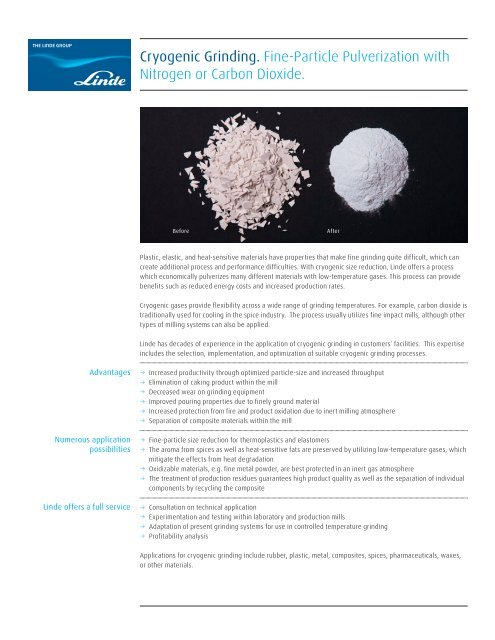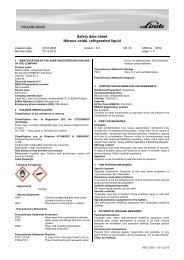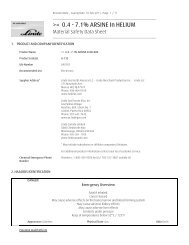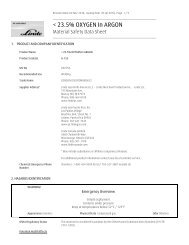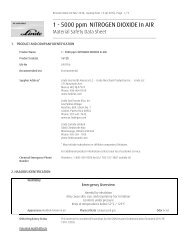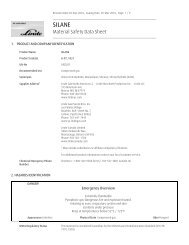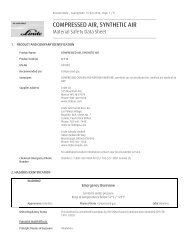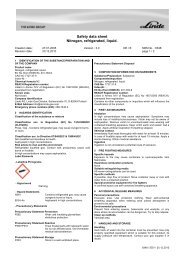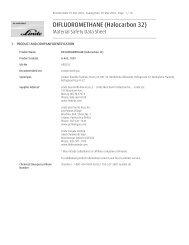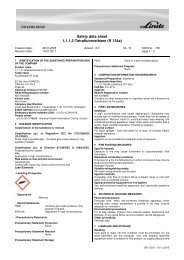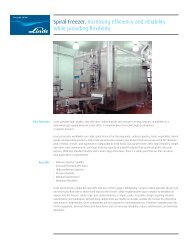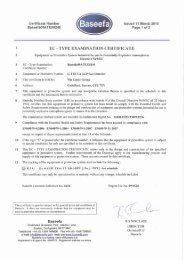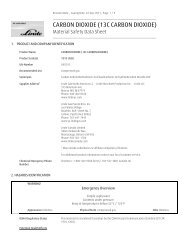Cryogenic Grinding - Linde North America
Cryogenic Grinding - Linde North America
Cryogenic Grinding - Linde North America
You also want an ePaper? Increase the reach of your titles
YUMPU automatically turns print PDFs into web optimized ePapers that Google loves.
<strong>Cryogenic</strong> <strong>Grinding</strong>. Fine-Particle Pulverization withNitrogen or Carbon Dioxide.BeforeAfterPlastic, elastic, and heat-sensitive materials have properties that make fine grinding quite difficult, which cancreate additional process and performance difficulties. With cryogenic size reduction, <strong>Linde</strong> offers a processwhich economically pulverizes many different materials with low-temperature gases. This process can providebenefits such as reduced energy costs and increased production rates.<strong>Cryogenic</strong> gases provide flexibility across a wide range of grinding temperatures. For example, carbon dioxide istraditionally used for cooling in the spice industry. The process usually utilizes fine impact mills, although othertypes of milling systems can also be applied.<strong>Linde</strong> has decades of experience in the application of cryogenic grinding in customers‘ facilities. This expertiseincludes the selection, implementation, and optimization of suitable cryogenic grinding processes.AdvantagesNumerous applicationpossibilities<strong>Linde</strong> offers a full service→→Increased productivity through optimized particle-size and increased throughput→→Elimination of caking product within the mill→→Decreased wear on grinding equipment→→Improved pouring properties due to finely ground material→→Increased protection from fire and product oxidation due to inert milling atmosphere→→Separation of composite materials within the mill→→Fine-particle size reduction for thermoplastics and elastomers→→The aroma from spices as well as heat-sensitive fats are preserved by utilizing low-temperature gases, whichmitigate the effects from heat degradation→→Oxidizable materials, e.g. fine metal powder, are best protected in an inert gas atmosphere→→The treatment of production residues guarantees high product quality as well as the separation of individualcomponents by recycling the composite→→Consultation on technical application→→Experimentation and testing within laboratory and production mills→→Adaptation of present grinding systems for use in controlled temperature grinding→→Profitability analysisApplications for cryogenic grinding include rubber, plastic, metal, composites, spices, pharmaceuticals, waxes,or other materials.
→ <strong>Cryogenic</strong> <strong>Grinding</strong>. 2 of 2Process examplefor grinding spices<strong>Cryogenic</strong> grinding of spices is a method of pulverizing the material at low temperatures. Traditional grindingprocesses generate heat that can degrade or reduce the volatility of a spice’s heat sensitive constituents such asaroma and flavor. The spices are frozen with cryogen such as liquid nitrogen (LIN/N 2 ) or carbon dioxide (CO 2 ) asthey are ground into a fine powder. This process preserves the quality of aroma and flavor within the productwithout damaging or altering the chemical composition of the spices.Spices are fed through a hopper to a conveyor system. While moving along the conveyor, the spices are sprayedwith the appropriate amount of cryogen. The material is then moved to a stainless steel auger that transports,grinds, and mixes the product and cryogen for an efficient cooling process. The cryogen absorbs the heat and isvaporized to a gaseous state, which is then expelled from the system through an exhaust system.The results are high quality spices at controlled partial sizes with no evaporation of essential values andnegligible loss of volatile components.<strong>Cryogenic</strong> grinding data (e.g. pepper)Particle SizeProduction RateNitrogen ConsumptionDriving Power700 μm1654 lb/h0.25 lb/lb pepper35 kW (47 hp)Process example forgrinding thermoplasticsA dosing wheel meters the plastic pellets, e.g. polyethylene or polyamide, into the mill. The grinding heat wouldnormally melt the thermoplastics, preventing the possibility of fine-particle grinding. However, cryogenic gasesprevent this by embrittling the material in a cooling conveying screw. The cryogenically ground plastic and thegas are collected in a bin. The pulverized product is then further processed through a cellular wheel sluice.The mill gas is purified with a filter and is released. The remaining gas is recycled back into the mill for heatintegration.The results are finely ground thermoplastics that maintain the quality of the processing equipment bypreventing melted material from impeding the system.<strong>Cryogenic</strong> grinding data (e.g. polyamide)Particle SizeProduction RateNitrogen ConsumptionDriving Power80 μm772 lb/h1.25 lb/lb polyamide21 kW (28 hp)Metering deviceDosing wheelValveGas regulatorBlowerCooling screwFine impactmiII<strong>Cryogenic</strong> gas supplyTICFilterCell wheelGround product<strong>Linde</strong> <strong>North</strong> <strong>America</strong>, Inc.575 Mountain Ave., Murray Hill, NJ 07974 USAPhone +1.800.755-9277, sales.lg.us@linde.com, www.lindeus.com<strong>Linde</strong> <strong>North</strong> <strong>America</strong> Inc. is a member of The <strong>Linde</strong> Group. <strong>Linde</strong> is a trading name used by companies within the <strong>Linde</strong> Group. The<strong>Linde</strong> logo is a trademark of The <strong>Linde</strong> Group. © The <strong>Linde</strong> Group 2013.1893_0113


